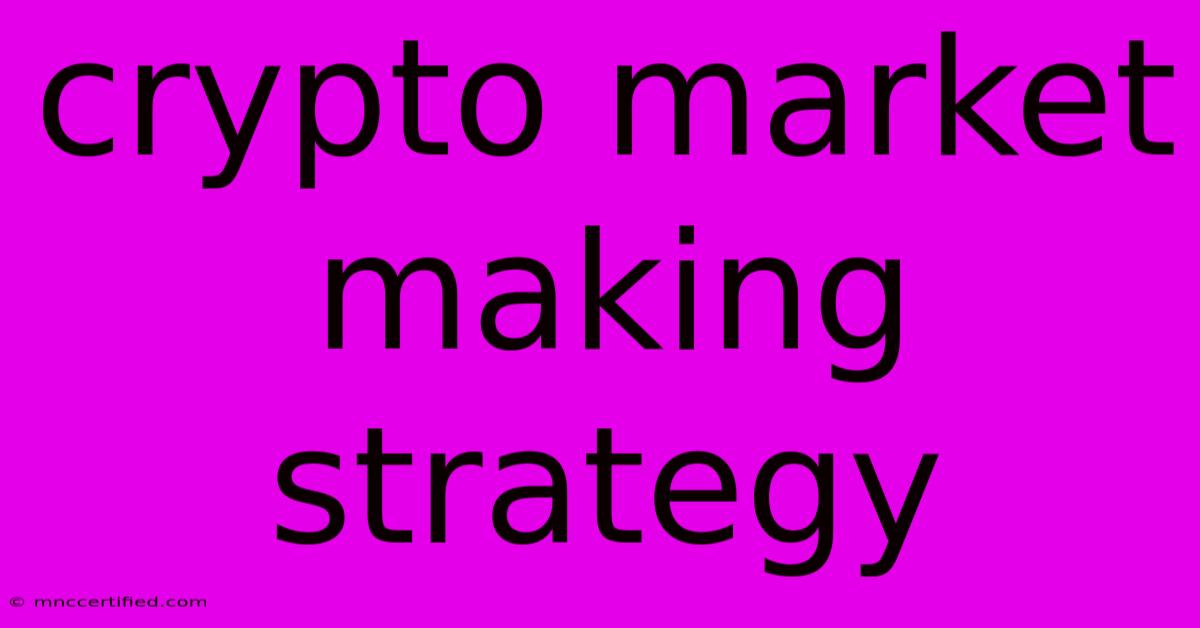Crypto Market Making Strategy

Table of Contents
Crypto Market Making Strategy: A Deep Dive for Professionals
The cryptocurrency market presents unique opportunities for high-frequency trading and arbitrage. A key strategy to capitalize on these opportunities is crypto market making. This involves providing liquidity to exchanges by simultaneously quoting buy and sell orders for various crypto assets. This guide delves into the intricacies of this strategy, highlighting its potential, risks, and essential considerations.
Understanding Crypto Market Making
At its core, crypto market making is about profiting from the bid-ask spread. Market makers set a slightly higher "ask" price (the price at which they're willing to sell) and a slightly lower "bid" price (the price at which they're willing to buy). The difference between these prices is the spread, and the market maker profits from the volume traded within this spread. The more volatile the market, the wider the spread, and potentially, the higher the profit.
Key Components of a Successful Strategy:
- Sophisticated Trading Algorithms: Manual market making is practically impossible in the fast-paced crypto world. High-frequency trading (HFT) algorithms are essential for reacting instantaneously to price fluctuations and executing trades efficiently. These algorithms need to be incredibly robust and handle massive data streams effectively.
- Deep Understanding of Order Book Dynamics: Analyzing the order book – a real-time record of buy and sell orders – is crucial. Successful market makers understand how order flow impacts price and can anticipate market movements to adjust their quotes strategically.
- Risk Management: This is paramount. The crypto market is notoriously volatile. Effective risk management involves setting appropriate position limits, diversifying across assets, and utilizing stop-loss orders to limit potential losses.
- Technological Infrastructure: High-speed, low-latency connections to multiple exchanges are vital. Robust infrastructure ensures minimal delays in executing trades and accessing real-time market data.
- Capital: Significant capital is necessary to withstand market fluctuations and maintain consistent liquidity provision. The amount needed depends on the trading strategy, the volatility of the assets traded, and the desired trading volume.
Types of Crypto Market Making Strategies:
Several approaches exist within crypto market making:
1. Passive Market Making:
This involves setting and maintaining a consistent bid-ask spread, regardless of short-term market fluctuations. It's a lower-risk approach, relying on consistent, smaller profits over time. It's suitable for traders with less risk tolerance and lower capital.
2. Active Market Making:
This strategy is more aggressive, adjusting bids and asks based on real-time market analysis and predictions. It aims for larger profits by exploiting short-term price discrepancies and taking advantage of temporary imbalances in supply and demand. This approach requires sophisticated algorithms and a higher risk tolerance.
3. Arbitrage Market Making:
This involves exploiting price differences of the same asset across different exchanges. By simultaneously buying on one exchange and selling on another, market makers capture the price differential. This requires lightning-fast execution and a deep understanding of exchange-specific dynamics.
4. Statistical Arbitrage:
This strategy uses statistical models to identify temporary mispricings within a portfolio of crypto assets. It leverages correlations and other statistical relationships to capitalize on temporary deviations from equilibrium.
Risks Associated with Crypto Market Making:
- Volatility: The highly volatile nature of crypto markets presents a significant risk. Unexpected price swings can lead to substantial losses if not managed effectively.
- Impermanent Loss: For market makers using decentralized exchanges (DEXs), impermanent loss is a significant concern. This refers to the loss of potential profits that could have been earned by simply holding the assets instead of providing liquidity.
- Smart Contract Risks: Using DEXs involves interacting with smart contracts, which are susceptible to bugs and vulnerabilities. Exploits could lead to significant financial losses.
- Regulatory Uncertainty: The regulatory landscape for cryptocurrencies is constantly evolving, introducing uncertainties and potential legal risks for market makers.
- Competition: The crypto market making space is becoming increasingly competitive, putting pressure on profit margins.
Conclusion: Is Crypto Market Making Right for You?
Crypto market making can be extremely lucrative, but it's not for the faint of heart. It requires significant capital, advanced technical skills, and a high tolerance for risk. Thorough research, meticulous planning, and robust risk management are crucial for success. Before embarking on this path, carefully weigh the potential rewards against the substantial risks involved. Consult with experienced professionals and thoroughly test your strategies in a simulated environment before deploying them with real capital. The crypto market is dynamic, and adaptability is key to long-term success in market making.

Thank you for visiting our website wich cover about Crypto Market Making Strategy. We hope the information provided has been useful to you. Feel free to contact us if you have any questions or need further assistance. See you next time and dont miss to bookmark.
Featured Posts
-
Clearfil Se Bond Instructions
Nov 28, 2024
-
113 Bond Drive Morganville Nj
Nov 28, 2024
-
Is A Hot Tub A Good Investment
Nov 28, 2024
-
Bonds Escape Room Promo Code
Nov 28, 2024
-
Old Grand Dad Bottled In Bond
Nov 28, 2024